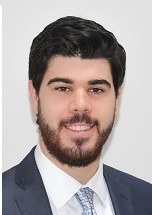Absolute Dosimetry of Ultra-High Dose Rate Pulsed Electron Beams Using a Graphite Probe Calorimeter
F Keszti*1, A Bourgouin2, A Schueller2, W Simon3, A Schoenfeld3, J Seuntjens1, J Renaud4, (1) McGill University, Montreal, QC, CA, (2) Physikalisch-Technische Bundesanstalt (PTB), Braunschweig, Lower Saxony, DE, (3) Sun Nuclear Corporation, Melbourne, FL, (4) National Research Council Canada, Ottawa, ON, CA
Presentations
TU-F-TRACK 5-6 (Tuesday, 7/27/2021) 4:30 PM - 5:30 PM [Eastern Time (GMT-4)]
Purpose: To evaluate and verify the dosimetric response of a clinically-deployable probe-format graphite calorimeter when operated in ultra-high dose rate (or ‘FLASH’) pulsed electron beams.
Methods: The ion chamber-sized graphite calorimeter, termed Aerrow, was operated in quasi-adiabatic mode. In this mode, the absorbed dose deposited in the graphite core can be obtained by calculating the product of the specific heat capacity and the radiation-induced temperature rise. The measurements were carried out at the Metrological Electron Accelerator Facility of the German National Metrology Institute (PTB). Ultra-high dose rate pulses were delivered with a 20 MeV electron beam. The dose-per-pulse was varied in the range of 0.5 – 5.5 Gy. The detector response measurement was repeated 5 times for each pulse, with pulse deliveries separated by 90 seconds. The pulse charge was monitored non-destructively with a previously validated beam current transformer (ICT). Dose conversion factors from graphite to water were calculated using the EGSnrc Monte Carlo code system. The heat transfer correction factor was assessed through finite element analysis using COMSOL Multiphysics.
Results: The response of the calorimeter was found to be independent of dose-per-pulse in the investigated range of pulse charges. The absorbed dose values measured by Aerrow had an average absolute deviation of 0.11 % and a maximum absolute deviation of 0.42 % from the fit on the ICT signals (which have uncertainties of 0.05 %). The response uncertainty corresponding to a coverage factor of k = 2 was 0.2 % (on average) for the higher dose rates (≥ 4.5 Gy/pulse) and reached a maximum of 1 % at the lowest dose rate.
Conclusion: This feasibility study demonstrates that Aerrow can produce accurate and reproducible dose measurements in the ultra-high dose rate regime of pulsed electron beams, making it a suitable candidate for absolute dosimetry of clinical FLASH radiotherapy beams.
Funding Support, Disclosures, and Conflict of Interest: This work was supported financially by the CREATE Medical Physics Research Training Network grant of the Natural Sciences and Engineering Research Council (NSERC) (#432290) and NSERC operating grant (#RGPIN 2019-06746). Absorbed dose calorimetry research at McGill University is in part supported by Sun Nuclear Corporation.
Handouts
Keywords
Absolute Dosimetry, Radiation Detectors, Electron Therapy
Taxonomy
TH- Radiation Dose Measurement Devices: Development (new technology and techniques)
Contact Email




